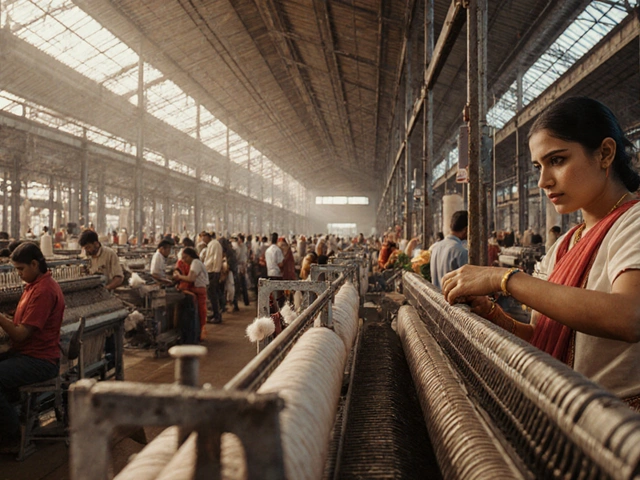The pharmaceutical distribution network in the USA is dominated by three giants. Known collectively as the Big 3, these companies ensure that medicines flow smoothly from manufacturers to healthcare providers. They are key players in the industry, setting standards for efficiency and reliability.
For Indian pharmaceutical manufacturers, the sheer size and complexity of the US market can be both a challenge and an opportunity. Understanding who holds the reins in this vast network is crucial. By diving into the workings of these major distributors, Indian firms can better position themselves to forge meaningful relationships and find a foothold in the US market.
Let's explore who's who among the top players and discover how Indian manufacturers can tap into this valuable network.
- Understanding the USA Pharma Distribution Landscape
- The Role of Major Distributors in Healthcare
- Profile of the Big 3 Distributors
- Opportunities for Indian Pharma Manufacturers
- Strategies to Collaborate with USA Distributors
Understanding the USA Pharma Distribution Landscape
In the expansive world of the U.S. pharmaceutical industry, the distribution landscape is a critical backbone, ensuring that medications efficiently and effectively reach patients who need them. At the heart of this landscape, the Big 3 pharma distributors have established themselves as pivotal cogs in the machinery of healthcare. Cardinal Health, McKesson, and AmerisourceBergen together control a substantial portion of the distribution network, managing complex logistics systems that connect manufacturers with pharmacies, hospitals, and clinics across America. These companies not only handle extensive logistics but also tackle regulatory challenges, ensuring compliance with federal and state norms while maintaining the flow of pharmaceuticals.
The journey of a medicine from an India pharma manufacturer to a consumer's hand in the U.S. is a testament to globalization in healthcare today. India, recognized globally for its production of generic drugs, plays a transformative role in supplying medicines to the U.S. market, yet faces intricate challenges, including navigating through regulatory pathways and establishing supply chain integrity. The U.S. distributors have responded by investing significantly in technology, creating robust platforms to track and monitor inventory levels, manage orders, and provide transparency in delivery timelines, all crucial for maintaining trust in a system that demands absolute reliability.
Indentured by a multitude of guidelines set by the FDA and other bodies, these USA pharmaceutical supply networks require distributors to constantly innovate and adapt their operations. A recent report noted that over 95% of prescriptions are distributed through these networks, a staggering fact that underscores the significance of their role. According to the Healthcare Distribution Alliance, "Efficient and accurate distribution is the keystone of public health infrastructure," highlighting the indispensable nature of these entities.
Beyond logistics, these distributors are thought leaders in pharmaceutical standards and often influence policy discussions that shape the future of the industry. Considerable investments have been made towards cold chain logistics for biologics and specialty drugs, areas of rapid growth, offering new opportunities for Indian manufacturers eager to expand their portfolio presence. Moreover, with the shift towards personalized medicine, these distribution giants are adapting continuously, offering tailored solutions that align with patient-centric models of care. They are vital collaborators for manufacturers, enabling them to focus on R&D and production while ensuring their products reach hands globally without delay.
The Role of Major Distributors in Healthcare
In the vast and intricate healthcare system of the USA, pharma distributors serve as the crucial linchpins that connect pharmaceutical manufacturers to healthcare providers. These distributors are responsible for ensuring that hospitals, pharmacies, and clinics receive the necessary medications in a timely and efficient manner. Their role goes beyond mere logistics; they provide strategic solutions to manage inventories, control costs, and enhance supply chain effectiveness. The ability to distribute medications swiftly and accurately can be a matter of life and death, underscoring the monumental responsibility these companies shoulder.
One of the prominent responsibilities of these distributors is to maintain a robust and secure supply chain. With the rise in global demand for medications, ensuring that the supply chain is resilient to disruptions is of utmost importance. The distributors not only move products but also manage the supply chain's digital infrastructure. This involves tracking prescription medications and ensuring compliance with national and international regulations, which is critical for preventing counterfeit drugs from entering the supply chain. A system known as track-and-trace is employed to achieve this, whereby each product is given a unique identifier that tracks its path from production to the hospital or pharmacy's shelf.
Another key role of these distributors is in managing costs and enhancing efficiency within the healthcare delivery process. By leveraging sophisticated technology and collaborating closely with manufacturing partners, the distributors help to monitor and predict pharmacy and hospital needs, allowing for just-in-time inventory management. This reduces the need for excessive stockpiling and mitigates the risks associated with waste due to expired products. A streamlined process not only curtails wastage but also significantly reduces costs, which is then translated into affordable healthcare for end consumers.
In terms of ensuring patient safety, distributors are pivotal. They provide a range of support services including specialized transportation for sensitive products like biologics that require cold-chain logistics. This requires a meticulously controlled environment to maintain the requisite temperatures from the moment they leave the manufacturing facility until they reach the ultimate consumers. As the healthcare industry increasingly leans toward personalized medicine, the role of USA pharmaceutical supply chains in delivering specialized medications becomes ever more pronounced.
Many distributors now collaborate directly with healthcare facilities to support their operation beyond mere drug supply. They provide consultation and technological services aimed at enhancing patient care and facilitating better health outcomes. As part of their evolving role, distributors are investing heavily in data analytics and artificial intelligence to predict trends and refine their strategic planning. This progressive approach ensures that they remain ahead of the curve, ready to meet the ever-changing demands of the healthcare landscape.
"Effective distribution networks are the backbone of healthcare, shaping not only the accessibility of medicines but also the reliability of patient care," says an industry expert in a recent health economics forum.
In conclusion, the leading pharma distributors in the USA play an indispensable role in maintaining the seamless functioning of the nation's healthcare system. Their commitment to pioneering innovative solutions continues to influence both domestic and international pharmaceutical landscapes, presenting strategic opportunities for Indian pharma manufacturers to collaborate and expand their reach into the US market.

Profile of the Big 3 Distributors
When discussing pharmaceutical distribution in the USA, it's impossible to overlook the sheer influence of the Big 3. These companies – McKesson Corporation, Cardinal Health, and AmerisourceBergen – collectively manage an overwhelming portion of the nation’s pharmaceutical distribution. This trifecta ensures that healthcare providers, ranging from tiny clinics to vast hospital networks, receive the medicines and supplies they need to operate efficiently. Each of these giants boasts decades of operational expertise, innovation, and adaptability, crucial factors in a market teeming with complexities. Their extensive networks and logistical capabilities have made them linchpins in the healthcare supply chain. Yet, they don’t just deliver; they’ve redefined the very mechanics of how pharmaceuticals move across the country, setting standards for reliability and efficiency.
McKesson Corporation
McKesson Corporation, founded in 1833, is the oldest of the three and one of the largest in terms of revenue. By exploring innovative solutions and technologies, McKesson has cultivated a robust distribution network that spans multiple countries, underlining its commitment to global healthcare. The company's focus on technology has led to significant advancements in supply chain management, improving both speed and accuracy. Through its comprehensive approach, McKesson ensures that USA pharmaceutical supply is consistently reliable and efficient. Their immense warehouse facilities, cutting-edge logistics software, and a well-coordinated delivery framework demonstrate an unparalleled command over the market. "McKesson is committed to leveraging innovative technology to enhance the future of healthcare," remarked a company spokesperson recently, highlighting their continuous drive for improvement.Cardinal Health
Next in line is Cardinal Health, a firm that has carved its niche with its unwavering dedication to improving the quality and cost-effectiveness of healthcare. It focuses on providing customized solutions tailored to meet the unique needs of its clientele, ranging from large health systems to small pharmacies. Its pioneering supply chain solutions have not only improved delivery times but have also helped in reducing costs, making healthcare more accessible. This strategic focus has made Cardinal Health an indispensable part of the North American healthcare narrative. By actively collaborating with India pharma manufacturers, Cardinal Health has further expanded its horizons, fostering cross-continental partnerships and ensuring a steady supply of quality pharmaceuticals.AmerisourceBergen
Lastly, AmerisourceBergen stands as a testament to what effective mergers and strategic vision can achieve. By blending the strengths of historically significant companies, AmerisourceBergen has continually adapted to the evolving pharmaceutical landscape. Its holistic approach covers everything from distribution logistics to patient support services. With a particular emphasis on leveraging data-driven insights, the company has become adept at predicting trends and adapting swiftly. Their collaborative ethos has facilitated seamless integration of global pharmaceutical players into the healthcare distribution framework of the USA. It’s no wonder they are considered a backbone of American healthcare, ensuring pharmacies never run out of essential medications.Collaboration and Innovation
Each of these distributors, while functioning independently, shares common ground in their continuous pursuit of innovation and collaboration. By embracing new technologies and fostering international partnerships, they not only support the vast American healthcare network but also extend opportunities to burgeoning markets, including those in India. Through robust communication channels and shared goals, the Big 3 have built bridges that link global suppliers to the massive and intricate market of the US, a move that only solidifies their standing as leaders in the field. Their stories are not just about distribution; they are about transformation, resilience, and the relentless drive to ensure that life-saving medicines are within reach for every American.Opportunities for Indian Pharma Manufacturers
Indian pharma manufacturers have watched the evolving healthcare dynamics of the United States with a keen eye, recognizing it as a fertile ground for growth and expansion. Known for their cost-effective production techniques, Indian companies bring a competitive edge in the global market that often translates into tempting offerings for the Big 3 pharma distributors. But why is the US market particularly ripe for Indian firms? One reason lies in the increasing demand for generic medicines driven by the country's need to balance quality with affordability in healthcare. Indian manufacturers excel in this domain, providing high-quality generics at competitive prices, thus creating natural synergy with American distributors who manage substantial inventories for hospitals and pharmacies nationwide.
The journey, however, is not without its hurdles. Regulatory compliance in the US, managed by the FDA, demands stringent adherence, and Indian companies aiming for success must navigate this roadmap meticulously. Many Indian firms have turned this challenge into an opportunity by investing significantly in R&D and upgrading their facilities to meet global standards, thereby enhancing their reputation and competitive position. Reports indicate that Indian pharma's share in the US generics market is an impressive 40%, a testament to their increasing foothold. Understanding and aligning with FDA regulations pave the way for smoother operations and open doors for collaborations with firms like McKesson, AmerisourceBergen, and Cardinal Health.
Aligning with the right partners is crucial, and Indian manufacturers are engaging in strategic alliances with US-based companies to bolster their market entry strategies. Through joint ventures and partnerships, they can leverage the established supply chains and logistics expertise of the Big 3 distributors. A significant advantage of such partnerships is that they provide valuable insights into American market consumer preferences, helping Indian firms tailor their offerings accordingly. To put this into perspective, about 90% of American prescriptions are filled with generics, making it clear that collaboration is indeed the name of the game.
The Director of the Indian Pharmaceutical Alliance once noted, "The US market presents enormous possibilities, and Indian pharma companies need to approach it with strategic precision. Emphatic strides in quality and compliance are reshaping global perceptions about India’s pharmaceutical capabilities."
Emerging trends in digital health and personalized medicine in the US present novel opportunities as well. Indian manufacturers, with their capable and flexible production systems, stand uniquely positioned to tap niche segments that require tailored pharmaceutical offerings. Focusing on specialty drugs and biosimilars can enhance their competitive positioning and broaden collaboration scopes with the Big 3, who are eager to expand their lines to accommodate personalized healthcare directives.
Indian firms also benefit from a robust biotechnology sector brimming with innovation that can be harnessed in developing complex therapeutics. The potential alignment with US-based research hubs through these distributors not just strengthens market presence but accelerates the pace of technological integration. Given this backdrop, Indian pharmaceutical companies find ample opportunity in the pursuit of US market engagement, capitalizing on the foundational strengths and forward-thinking strategies to establish enduring partnerships with major pharma distributors.

Strategies to Collaborate with USA Distributors
Entering the US pharmaceutical market is both an exciting and challenging endeavor for India pharma manufacturers. When it comes to forging relationships with the top distributors, like the Big 3 pharma distributors, understanding their operational frameworks and expectations becomes essential. A good strategy begins with comprehensive research about these distributors. Their distribution channels, customer base, and service specialties need to be understood thoroughly before making any move. This knowledge not only saves time but also enhances negotiation capabilities and partnership propositions. Recognizing whom they serve and how they operate gives a manufacturer the upper hand in tailoring their approach to suit each distributor's unique needs.
Building trust is another central tenet of successful collaboration. Indian manufacturers should showcase their compliance with US regulations, as this is often a key priority for USA pharmaceutical supply chains. Providing clear evidence of FDA-approved facilities or established quality assurance processes goes a long way. Moreover, face-to-face interactions, be it through international conventions or arranged business trips, can cement relationships. Understanding cultural differences, business etiquettes, and the value of prompt communication helps in maintaining smooth and effective interactions.
A competitive pricing strategy is equally important. Understanding the pricing strategies employed by the Big 3 pharma distributors and remaining flexible yet sustainable with pricing models can make Indian manufacturers more attractive to partners. Offering flexible payment terms or volume-based discounts provide added incentives. When pricing is balanced with quality assurance, it creates a strong selling proposition for the distributor, addressing their primary need for value creation.
Marketing plays a vital role. Manufacturers should understand that distributors look favorably on partners who can create demand for their products. Offering comprehensive marketing support and demonstrating a solid track record in branding and customer engagement can set a manufacturer apart. Demonstrating success in other markets, with tangible outcomes of effective campaigns, can be persuasive. As a distributor is tasked with ensuring consistent product movement, a manufacturer who can complement this with a robust marketing plan is often preferred.
"A productive partnership with a distributor is built on aligning business goals and sustaining a mutual drive for growth." - Industry Expert
Finally, flexibility in logistics and adaptability to the fast-paced nature of the US market can significantly impact collaboration success. Offering customized solutions, supply chain predictability, and swift adaptability in response to market demands fosters a sense of reliability. Adequate warehousing, efficient inventory management systems, and prompt delivery timelines are crucial components that enhance operational effectiveness. Combined, these virtues create a more appealing proposition to the distributors who hold the keys to market access.
With these strategies, India pharma manufacturers can make strides in the US while simultaneously supporting the goals and operational expectations of their distributor partners.






